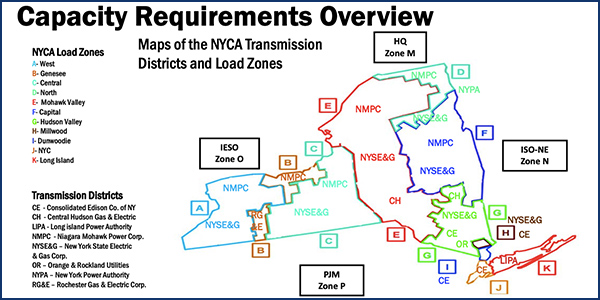By Michael Kuser
FERC on Thursday denied rehearing of its October 2018 order accepting NYISO’s revisions to the methodology it uses to determine locational minimum installed capacity requirements (LCRs), rejecting every one of the more than two dozen arguments made by the Long Island Power Authority (LIPA) and its subsidiary, Power Supply Long Island (ER18-1743-002).
NYISO’s installed capacity (ICAP) market rules require all load-serving entities to purchase a specified amount of capacity to count toward the statewide minimum installed reserve margin (IRM), based on each LSE’s coincident peak load. LSEs with customers in certain transmission-constrained areas, defined as “localities,” must fulfill a portion of their respective purchase obligations from capacity resources electrically located within those areas.
NYISO has designated three such localities: G-J, which is composed of load zones G, H, I and J in the Lower Hudson Valley; New York City (Zone J), which is nested within G-J; and Long Island (Zone K).
With the creation of the G-J locality, NYISO supplemented its former method, which recognized that the loss-of-load-expectation (LOLE) reliability standard used in setting the IRM may be achieved by carrying many different combinations of ICAP in various locations. The ISO now takes steps to calculate the LCR for the G-J locality.
In Thursday’s order, the commission found that the ISO’s alternative LCR methodology satisfies the 0.1-days/year LOLE reliability standard, which LIPA asserted was insufficiently demonstrated or certified.
“NYISO presented sufficient record evidence in this proceeding to support its claim that the alternative LCR methodology will meet the 0.1-days/year LOLE reliability standard,” the commission said. “Moreover, LIPA has not provided evidence that would persuade us otherwise.”
The commission also rejected LIPA’s request for additional technical details in the Tariff.
“We find unpersuasive arguments that the commission failed to address … NYISO’s alleged failure to model and analyze ‘known’ likely future system conditions; and the sensitivity of the alternative LCR methodology to actions, such as election of unforced deliverability rights, taken in Zone J that adversely affect Zone K,” the commission said. “LIPA’s arguments reduce to a disagreement with NYISO regarding the number and type of sensitivity analyses” that need to be performed.



